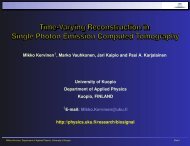USER'S GUIDE - Biosignal Analysis and Medical Imaging Group
USER'S GUIDE - Biosignal Analysis and Medical Imaging Group
USER'S GUIDE - Biosignal Analysis and Medical Imaging Group
- No tags were found...
Create successful ePaper yourself
Turn your PDF publications into a flip-book with our unique Google optimized e-Paper software.
Chapter 2Heart rate variabilityHeart rate variability (HRV) describes the variations between consecutive heartbeats. Therhythm of the heart is controlled by the sinoatrial (SA) node, which is modulated by boththe sympathetic <strong>and</strong> parasympathetic branches of the autonomic nervous system. Sympatheticactivity tends to increase heart rate (HR↑) <strong>and</strong> its response is slow (few seconds)[3]. Parasympathetic activity, on the other h<strong>and</strong>, tends to decrease heart rate (HR↓) <strong>and</strong>mediates faster (0.2–0.6 seconds) [3]. In addition to central control, there are some feedbackmechanisms that can provide quick reflexes. One such mechanism is the arterial baroreflex.This reflex is based on baroreceptors which are located on the walls of some large vessels<strong>and</strong> can sense the stretching of vessel walls caused by pressure increase. Both sympathetic<strong>and</strong> parasympathetic activity are influenced by baroreceptor stimulation trough a specificbaroreflex arc, Fig. 2.1.The continuous modulation of the sympathetic <strong>and</strong> parasympathetic innervations resultsin variations in heart rate. The most conspicuous periodic component of HRV is the socalledrespiratory sinus arrhythmia (RSA) which is considered to range from 0.15 to 0.4Hz [3]. In addition to the physiological influence of breathing on HRV, this high frequency(HF) component is generally believed to be of parasympathetic origin. Another widelystudied component of HRV is the low frequency (LF) component usually ranging from 0.04to 0.15 Hz including the component referred to as the 10-second rhythm or the Mayer wave[3]. The rhythms within the LF b<strong>and</strong> have been thought to be of both sympathetic <strong>and</strong>parasympathetic origin [3] even though some researchers have suggested them to be mainlyof sympathetic origin [25]. The fluctuations below 0.04 Hz, on the other h<strong>and</strong>, have notbeen studied as much as the higher frequencies. These frequencies are commonly dividedinto very low frequency (VLF, 0.003-0.04 Hz) <strong>and</strong> ultra low frequency (ULF, 0-0.003 Hz)b<strong>and</strong>s, but in case of short-term recordings the ULF b<strong>and</strong> is generally omitted [44]. Theselowest frequency rhythms are characteristic for HRV signals <strong>and</strong> have been related to, e.g.,humoral factors such as the thermoregulatory processes <strong>and</strong> renin-angiotensin system [3].Even though HRV has been studied extensively during the last decades within whichnumerous research articles have been published, the practical use of HRV have reachedgeneral consensus only in two clinical applications [44]. That is, it can be used as a predictorof risk after myocardial infarction [24, 18] <strong>and</strong> as an early warning sign of diabetic neuropathy[4, 33]. In addition, HRV has been found to correlate with, e.g., age, mental <strong>and</strong> physicalstress, <strong>and</strong> attention, see, e.g., the review in [3].The term HRV refers, in general, to changes in heart beat interval which is a reciprocalof the heart rate. This is also the case here. The starting point for HRV analysis is the ECGrecording from which the HRV time series can be extracted. In the formulation of the HRV16





